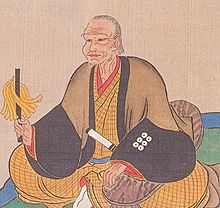Masayuki Sanada
| Sanada Awanokami Masayuki | |
|---|---|

Sanada Masayuki
|
|
| Lord of Ueda | |
|
In office 1585–1600 |
|
| Preceded by | Sanada Yukitaka |
| Succeeded by | Sanada Nobuyuki |
| Personal details | |
| Born | 1547 |
| Died | July 13, 1611 (aged 63/64) |
| Nationality | Japanese |
| Spouse(s) | Kansho-in |
| Children |
Sanada Nobuyuki Sanada Yukimura Kikuhime (b.1580), married Takigawa Kazuatsu |
| Military service | |
| Battles/wars | |
Sanada Awanokami Masayuki (真田 安房守 昌幸?, 1547 – July 13, 1611) was a Japanese Sengoku period lord and daimyō. He was the head of Sanada clan, a regional house of Shinano Province, which became a vassal of the Takeda clan of Kai Province.
Along with his father and brothers, Masayuki served the Takeda clan during its heyday, when it was led by Takeda Shingen. After its downfall, Masayuki took the lead of his clan and, despite little power, he managed to establish himself as an independent daimyō under the Toyotomi regime through skillful political maneuvers amidst the powerful Tokugawa, Hojō and Uesugi clans.
Known for having defeated the powerful Tokugawa army in the Siege of Ueda on two separate occasions, Masayuki is now considered one of the greatest military strategists of his era. In recent times, a number of portrayals in novels, films and other forms of media have contributed to his increased popularity.
He was born the third son of Sanada Yukitaka in 1547, but the exact date is unknown. His childhood name was Gengorō (源五郎). At birth, he had no right to succeed his father because of his two older brothers, Nobutsuna and Masateru.
In 1553, at seven years old, he was sent to the Takeda clan's headquarters in Kai as a hostage. There he becomes part of the Okukinjūshū (奥近習衆), a group of six young servants close to Takeda Shingen. According to the Kōyō Gunkan, Shingen favoured him as he soon recognized that Masayuki's talents and insight rivaled those of his father Yukitaka. As such, he is sometimes included among the Twenty Four Generals, alongside his father and two older brothers.
...
Wikipedia
